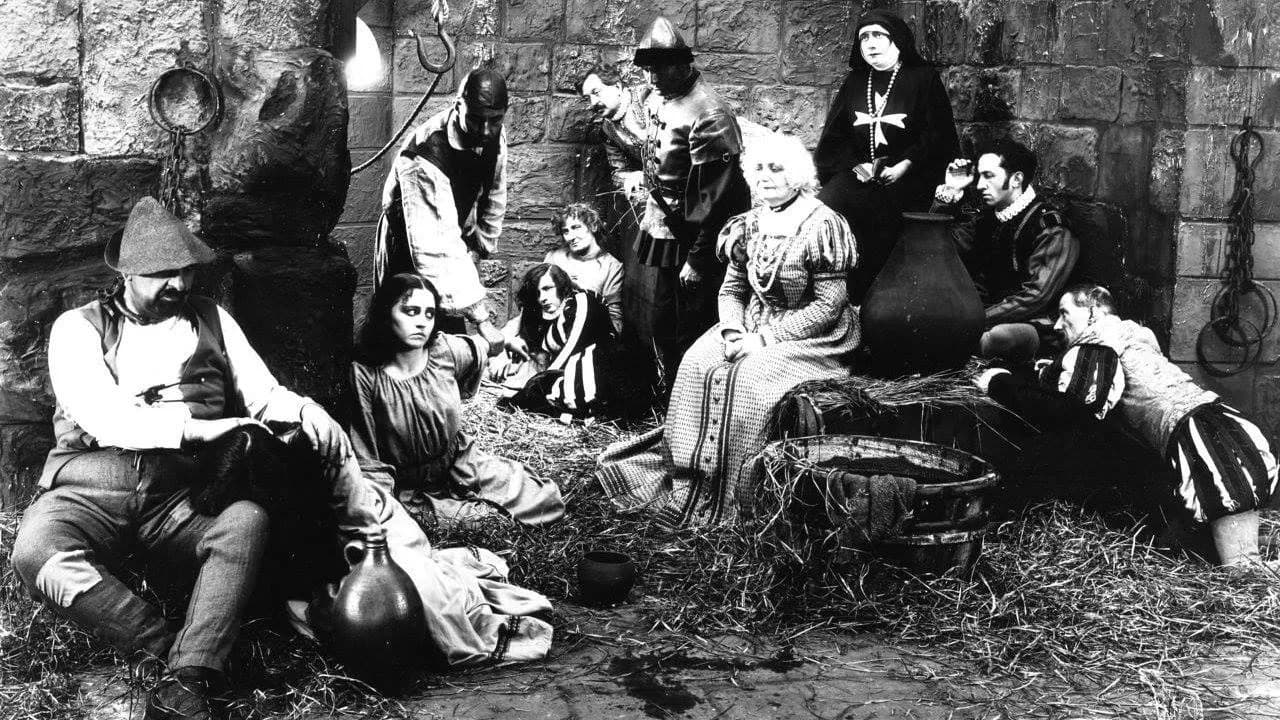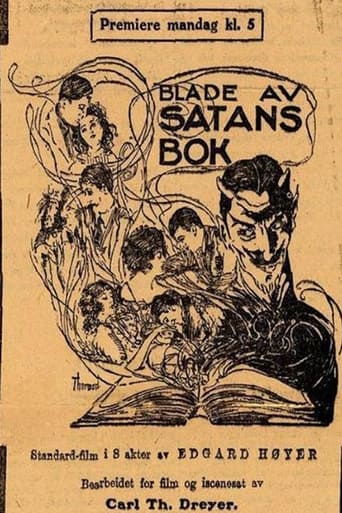SoftInloveRox
Horrible, fascist and poorly acted
Supelice
Dreadfully Boring
Kailansorac
Clever, believable, and super fun to watch. It totally has replay value.
Zlatica
One of the worst ways to make a cult movie is to set out to make a cult movie.
Claudio Carvalho
Satan is exiled from Heaven by God and doomed to stay on Earth. God states that for each soul who falls in temptation, his sentence will be increased in one hundred years; for each soul who resists, his sentence will be decreased in one thousand years. Satan is followed in dark moments of mankind history: the betrayal of Jesus by Judas; the Spanish Inquisition; the French Revolution; and the Finnish Civil War of 1918."Blade af Satans bog" is an ambitious (or pretentious) Danish epic about evil temptation through time. Carl Theodor Dreyer made this movie inspired in D. W. Griffith's epic "Intolerance". I saw the version released in Brazil on VHS with 108 minutes running time; therefore a version totally mutilated and it would be unfair if I write that the screenplay is messy. My vote is six.Title (Brazil): "Páginas do Livro de Satã" ("Pages from Satan's Book")
FerdinandVonGalitzien
"Blade Af Satans Bog" ( Leaves Out Of The Book Of Satan ) (1921) was Herr Dreyer's most ambitious early silent film, a big "Nordisk" film production that depicts a challenge between Satan and God spanning 2000 years; fortunately the Danish Film Institute has shortened such a huge lapse of time to 157 minutes in a recent and beautiful film restoration for the pleasure of silent film fans around the world.This age old conflict is represented by four episodes: the betrayal of Herr Jesus by Herr Judas, the Spanish Inquisition, the French Revolution and the Finnish civil war in 1918. In "Blade AF Satans Bog" there are echoes of Griffith and certainly "Intolerance" (1916) was a big influence on Dreyer in terms of his film's construction and narrative not to mention the moral treatise. However Dreyer, unlike Griffith, is more interested in ethics than spectacle. Blade Af Satans Bog" is basically a moral story in the shape of a big film production, in which evil deeds and human weaknesses became a metaphor and eternal parable. The moral treatise mentioned by this Herr Graf is probably the most interesting aspect of the picture as the Danish director carefully develops the struggle between evil and good: Satan disguised as a Pharisee, a Grand Inquisitor, a Jacobin leader and a Bolshevik monk, must tempt his victims by appealing to their inner human weaknesses. In the background to this fight is religion, betrayal, ambition and power. The fallen angel knows how to persuade men towards his evil ends but is aware that there is no real comfort finally in his cruel doings. It is this aspect of the story that really counts for Herr Dreyer and he takes splendid advantage of the many technical resources at his disposal for this big budget film.Herr George Schnéevoigt was the cinematographer of the film and does excellent work, especially during the scene wherein Herr Jesus is praying in the Garden of Gethsemane. He also captures the dark atmosphere of the Inquisition and provides a human portrait of Frau Marie Antoinette. The cinematographer's use of light and shadows captures the tragic mood perfectly. This Herr Graf does not overlook the splendid and restrained acting by Herr Helge Nissen who, as the wicked Herr Satan, achieves a brilliant portrayal in his four different guises.And now, if you'll allow me, I must temporarily take my leave because this German Count must continue to speak evil of one of his Teutonic rich heiress to another one.Herr Graf Ferdinand Von Galitzien http://ferdinandvongalitzien.blogspot.com
sveinpa
This pretentious historical drama of Satan's part in the treason of Jesus and the horrors of the Spanish inquisition, the French revolution and the Finnish civil war is stylistically a curious move backwards for Dreyer and the Danish film industry. After the technical innovations by director Benjamin Christensen, already in Det hemmelighedsfulde X (1914), as well as in Dreyers own first feature, Præsidenten (1919), which pioneered the use of both natural lightning and chiaroscuro effects that looked forwards to German expressionism, Blade af Satans bog returns to the all too brightly lit costume drama which dominated much of the early cinema. This means that even windowless rooms with only a few candles burning is lit up like it was broad daylight all over, eventually killing any sense of sinister atmosphere that the plots here surely calls for. Outside night scenes are likewise often shot in daylight, probably awaiting blue tinting. What could be genuinely scary with more imaginative lightning and a more cinematic style, remain lifeless tableaux. There are a few scenes that uses shadows to great effect, but in a film that is 157 minutes long the overall impact is rather dull, despite the excellent new, but untinted print provided on the DVD by the Danish Film Institute from a duplicate negative.Despite these shortcomings, there are many interesting touches for fans of Dreyer's more acclaimed work. For instance the torture scenes in Spain that anticipates the ones in Jeanne d 'Arc, and the many carefully arranged portrait pans of elders that is used again (more sophistically) in Ordet. In the Finnish episode we also get some very dramatic scenes that combines fast action with small details in close ups, expertly framed and imaginatively put together by cross cutting. After all the static of the previous episodes, the swiftness in Finland comes as a blessing and a fitting climax bringing the history lesson up to date. That is, if you don't mind the white propaganda - proves you don't have to be a bolshie to see red. Thematically, there is also the interesting touch that Dreyer shows his obsession with how personal love affairs often dominate the course of historical events. If someone is tortured or executed, you bet it is because she failed to satisfy her jealous lover, who then turns out to make faith work fatally against her. The white girl loaded with hand grenades that captures two reds just when they were about to execute a brave white fighter, is of course also on a personal revenge trip, even if it is all for Finland, of course. There are enough of such situations here for more than a few topical theses, but I'll leave it at that. Anyone interested in Dreyer should see this anyway. Oh, I forgot to mention Intolerance? But then it turns out, according to Casper Tybjerg, that the manuscript for Blade af Satans bog was written in 1913 (Oh yeah? I hear you say, but the Finnish episode is set in 1918? Go figure), and probably inspired by the Italian film Satanas by Luigi Maggi (1912), which (also probably?) inspired Intolerance. But Dreyer has confirmed that the close up of Siri's face in the Finnish suicide scene was directly inspired by the close up of Lilian Gish in Griffith's court scene. So there.
wes-connors
A story of Satan, who, according to the film, was originally God's "Angel of Light". But, He wanted to be God-like. As punishment, God periodically orders Helge Nissen (as Satan) to "'Continue thy evil doings!'" And, director Carl Theodor Dreyer traces the Evil One's deeds through the ages. The film concentrates on three historically set studies: the crucifixion of Christ, the Spanish Inquisition, and the French Revolution; with the fourth, and last, leaf in Satan's book the (then) contemporary Russian invasion/occupation of Finland. Dreyer is clearly inspired by D.W. Griffith's infinitely superior, and highly recommended, "Intolerance" (1916). Elith Pio (as Joseph) and Clara Pontoppidan (as Siri) give focal, heroic performances in the latter two stories.***** Blade af Satans bog (1921) Carl Theodor Dreyer ~ Helge Nissen, Clara Pontoppidan, Elith Pio

